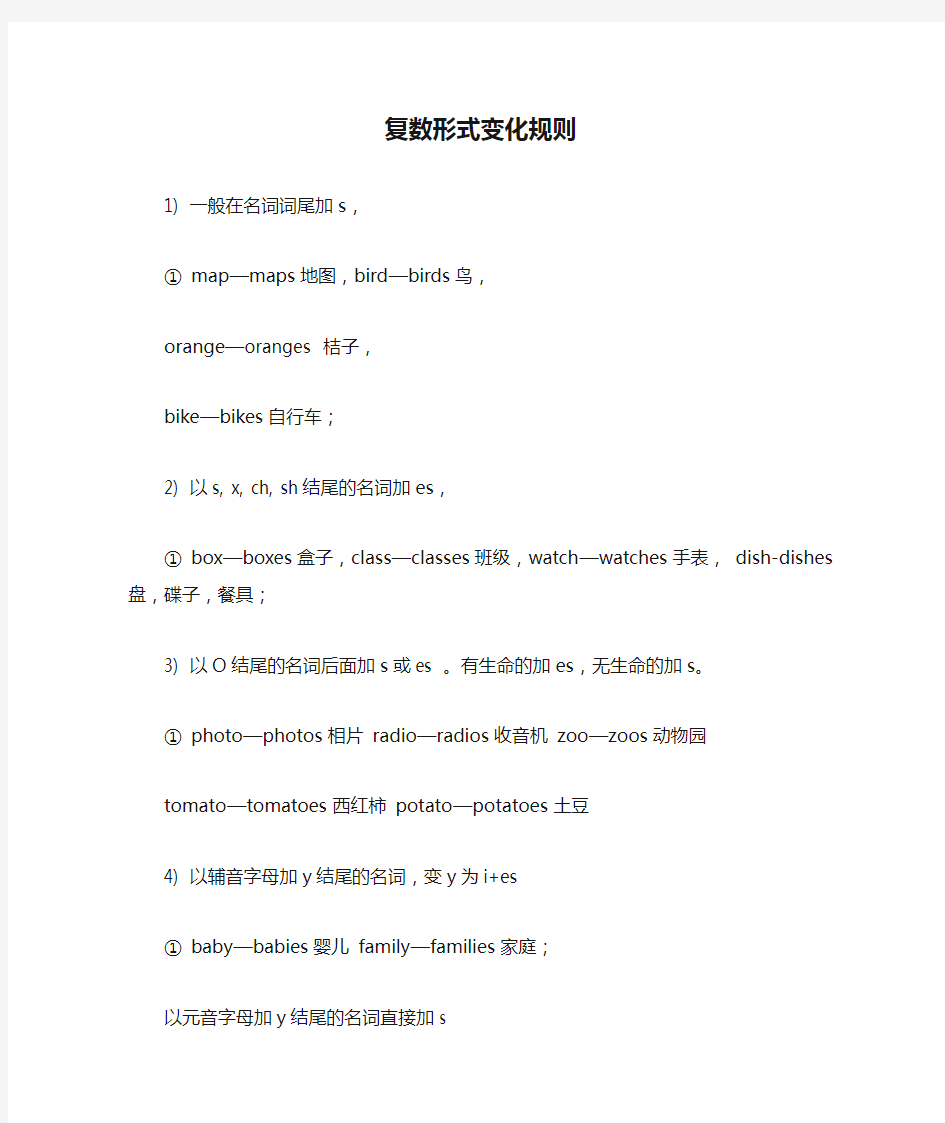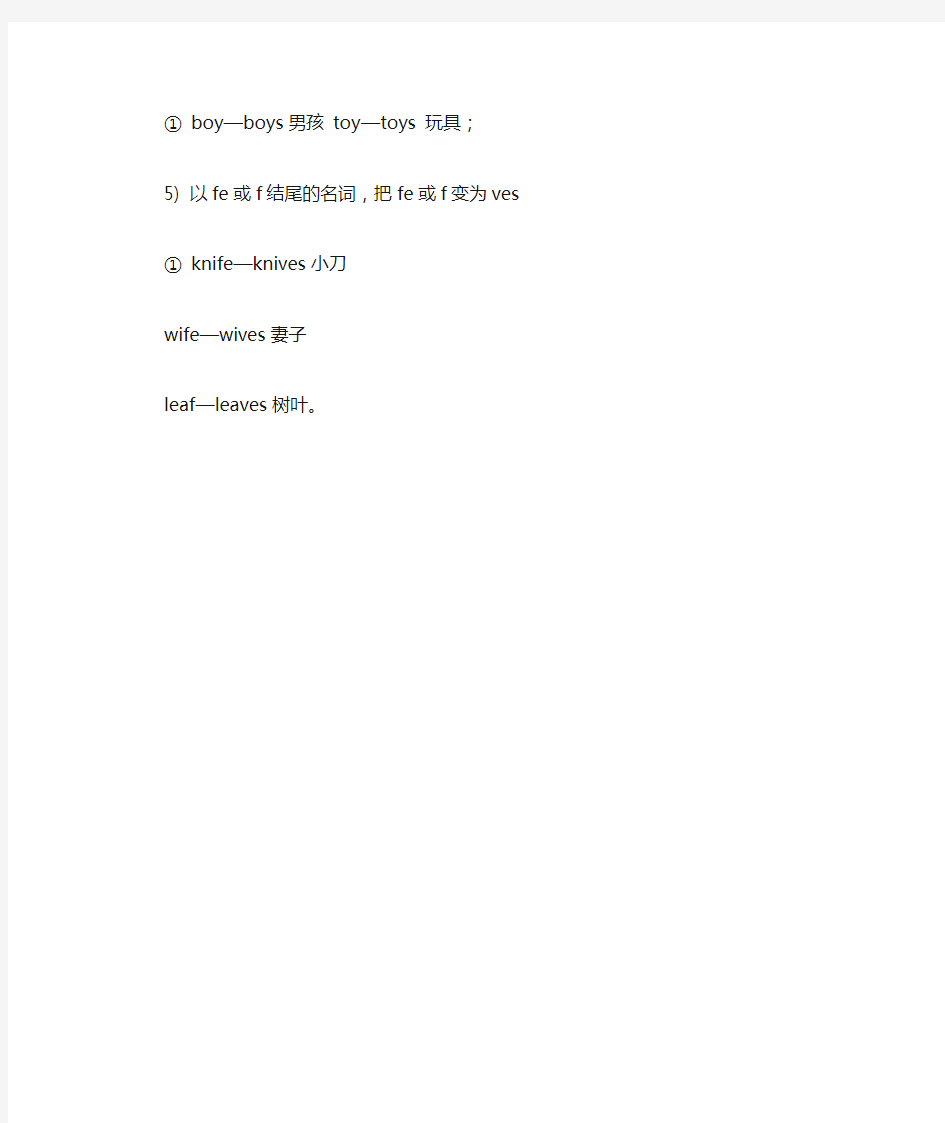

复数形式变化规则
1) 一般在名词词尾加s,
①map—maps地图,bird—birds鸟,
orange—oranges 桔子,
bike—bikes自行车;
2) 以s, x, ch, sh结尾的名词加es,
①box—boxes盒子,class—classes班级,watch—watches手表,dish-dishes 盘,碟子,餐具;
3) 以O结尾的名词后面加s或es 。有生命的加es,无生命的加s。
①photo—photos相片radio—radios收音机zoo—zoos动物园tomato—tomatoes西红柿potato—potatoes土豆
4) 以辅音字母加y结尾的名词,变y为i+es
①baby—babies婴儿family—families家庭;
以元音字母加y结尾的名词直接加s
①boy—boys男孩toy—toys 玩具;
5) 以fe或f结尾的名词,把fe或f变为ves
①knife—knives小刀
wife—wives妻子
leaf—leaves树叶。
可数名词和不可数名词复数变化规则 英语中的名词指的是一种抽象的或者具体的事物,它有可数和不可数之分。所谓可数名词指的就是在数量上可以计数,可以数出数量的事物;所谓不可数名词是指不能以数目来计算,不可以分成个体的概念、状态、品质、感情或表示物质材料的东西。 一、可数名词在它之前可以加上冠词a/an(以元音字母a,e,i,o,u开头的字母前冠词用an)。而不可数名词前面是不可以直接加冠词的。可数名词复数变化规律如下: a. 一般情况下,直接加 -s,如:book-books, bag-bags, cat-cats, bed-beds ;读音:清辅音后读[s],浊辅音和元音后读[z]。 b.以s,x,ch,sh结尾,加-es,如:bus-buses, box-boxes, brush-brushes, watch-watches ;读音:[iz]。 c.以“辅音字母+y”结尾,变y为i, 再加-es,如:family-families, baby-babies 婴儿;读音:[z]。 以“元音字母+y”结尾,直接加-s,如:monkey-monkeys,toy-toys 读音:[s]。 d.以“f或fe”结尾,变f或fe为v, 再加-es,如:knife-knives, leaf---leaves树叶;读音:[z]。e.以“o”结尾的词,分两种情况 1)有生命的加-es 读音:[z] 如:mango-mangoes,tomato-tomatoes ,hero-heroes 2) 无生命的加-s 读音:[z] 如:photo-photos,radio-radios f. 以ce,se,ze,de,ge结尾,加-s,如:exercise-exercises,读音:[z]。 g. 不规则名词:小老鼠爬灯台,偷油吃下不来。男人当警察,保护妇女跟儿童; 英国人的牙咬了法国人的脚;养了一头日本羊,送给了中国人; 养了一头鹿跟鹅,卖给了瑞士人。 man-men, woman-women, policeman-policemen, policewoman-policewomen, goose---geese鹅,mouse(老鼠)-mice, child-children, foot-feet, tooth-teeth, ox-oxen(公牛)h. 除此之外,还有一部分名词单复数同形,如: fish鱼,deer鹿,sheep绵羊,news 新闻,goods 商品,fish,people 人,human人类 i. 有一些名词则只有复数形式:trousers裤子,pants裤子,shorts短裤 glasses眼镜,compasses 圆规,scales天平,pliers钳子,clips剪子 j. “某国人”的复数有三种类型: (1)Chinese, Japanese, Swiss 三国人单数复数同形,不需加s; (2)Englishman, Frenchman, Dutchman复数要把 man 变为men; 注意:German的复数是Germans,它的man不是词根,而是由Germany演变过来的。(3)其他各国人以–an, -ian结尾的均直接加s。如:Americans, Australians, Indians等。 可依照这个口诀记忆:中日瑞士均不变,英法荷兰都要变,其他”s”加后面。
人称代词练习题 一、用人称代词主格代替下列各词或划线部分: 1. Mrs. Li 2. her uncle 3. Miss Liu 4. my family 5. my cousin and I 6. our pencils 7. its tail 8. his grandmother 9. your T-shirt 10. Bob 11.their pears 12. the park 13. Jenny 14. the animals 15. my mother and father 16. The car is red. 17. These books are on the desk. 18. My mother and I are at home. 19. Mr. Smith is a kind man. 20. Her aunt is a model.(模特) 二、用所给词义的适当形式填空: 1、 is a teacher. (她) 2、 is a good boy. (他) 3、 is in the classroom (它) 4、 are very smart today. (你) 5、 (你们) are students. 6、can’t find my ruler (我). Where is (它)? 7、 am a student. (我) _______like English very much. (我们) 8、 is my brother. (他) 9、I like her pencil case. is nice! (它) 10、________ are playing ping-pong in the park.(他们) 三.用括号中人称代词的适当形式填空 1.Her sister is helping _______(we). 2.John and I are in the same school. (we)go to school together. 3.Everyone likes_____(she), do (you)? 4.Danny gives the book to ______ . (you) 5.______(I) have many friends. Some of (they)are good at English. 6.Jim is English. ________(I) like playing with _______(he) 7.I love ________(they)very much. 8.Miss Li often looks after________(she) 9.They are waiting for__________(they). 10.Do you like Li Ming? No, ______(I) don’t like _____.(he)
1 名词变复数 一.名词变复数规则变化及发音: 1、绝大多数的可数名词在词尾加上s ; eg:book→books;desk→desks;pen→pens;car →cars s遇t读浊辅音[ts],遇d读清辅音[dz] eg:friend→friends; cat→cats; 2.、以s、x、ch、sh结尾的单词,在该词末尾加上-es;读音规则:读[iz]; eg:bus→buses; box →boxes; watch→watchches; dish→dishes 3、以辅音字母+y结尾的名词,要把y变为i,再加-es;读音规则:读[z]。 eg:fly→flies; baby →babies; 元音字母加y结尾的单词直接加s;eg:toy→toys;boy→boys; 4、以-f或-fe结尾的名词,要将-f或-fe变为-v,再加es;读音规则:读[vz]; eg:knife→knives;leaf→leaves; 5、以-o结尾的名词,初级阶段只有三个单词要加-es,其余都加-s;读音规则:读[z]。eg:tomato→tomatoes西红柿; potato→potatoes土豆; hero→heroes 英雄; Negro—Negroes 口诀:“黑人英雄喜欢吃土豆和西红柿”其余eg:zoo→zoos; hippo→hippos;二.名词变复数不规则变化: 1.单词内部发生变化:口诀―oo常常变ee,男人女人a变e‖ eg:foot→feet脚;tooth→teeth牙齿;man→men男人;woman→women女人; 2.单复数相同:―羊鱼小鹿无变化,单数复数是一家‖ eg:sheep→sheep绵羊;fish→fish鱼;deer →deer鹿; 3.不规则变化:child→children孩子;mouse→mice老鼠;German→Germans德国人; ⒈不可数名词概念:不可以数的名词叫做不可数名词。包括物质名词(表示无法分为个体的物质)和抽象名词(表示抽象概念的词)。 ⒉不可数名词特点: ⑴不可数名词没有复数形式,也不能与a, an及数词连用,常作单数看待。例: water There’s some water in the bottle. food My favorite food is noodles. ⑵不可数名词如表数量,常和a bottle of, a glass of等名词词组连用。如表示复数,只把量词改为复数。 例:a bottle of pop一瓶汽水 , two glasses of orange juice 两杯桔子汁, three cups of tea 三杯茶,a piece of paper一张纸 ⑶有些物质名词有时可数,有时不可数,要根据上下文决定,其意义也有所不同。 A glass is made of glass.玻璃杯是玻璃制成的。(玻璃杯可数,玻璃不可数。) I bought a melon yesterday. I want to eat some melon. 四.特殊名词的讲解: ⑴people 作“人们,人民”解时,只有复数形式,谓语动词作复数。作“民族”解时,单复数不同,复数要在词尾加s。 There are five people in my family. 我家有五口人。 There are fifty-six peoples in our country.我们国家有56个民族。 ⑵clothes,pyjamas(睡衣;宽长裤)等属于无单数形式的复数名词,谓语作复数。例:My favorite clothes are pants. These pyjamas are too small. ⑶ pants , shoes , glasses ,shorts,scissors等名词,由两部分构成,常以复数形式出现,谓语动词要用复数。要表示单数常用a pair of表示,此时如作主语,谓语要作单数看待。 例:Your pants are blue. This pair of pants is mine. ⑷集体名词看作整体时,谓语用单数; 指成员时,谓语用复数。 His family is a large family. His family like animals. 指整体指成员⑸有的名词单复数意思不同:
第二章名词变复数规律 一名词复数 1.“四十七”原则:单词以s, sh, ch结尾的要加-es; class—classes; dish---dishes; bench---benches; 2.巧记-f(e)结尾的名词复数: 将f变为v,再加es: 小偷之妻生活难,(thief, wife, life) 自己扫叶来做饭。(self, leaf) 忽见一狼躲架后,(wolf, shelf) 取刀把它劈两半。(knife, half) 直接加s变复数: 海湾边,屋顶上,首领奴仆两相望;(gulf, roof, chief, serf) 谁说他们无信仰,证据写在手帕上。(belief, proof, handkerchief)3. 巧记-o结尾的名词变复数: 加-es: 黑人英雄爱吃土豆和西红柿。 Negro hero potato tomato 4.巧记“某国人”变复数: ①英国人an Englishman --- two Englishmen 法国人a Frenchman --- two Frenchmen ②中国人a Chinese --- two Chinese 日本人a Japanese --- two Japanese 瑞士人a Swiss --- two Swiss ③美国人an American --- two Americans 德国人a German --- two Germans 澳大利亚人an Australian --- two Australians 5.单复数同形的名词: 中国人和日本人爱护绵羊,鹿和鱼。 Chinese Japanese sheep deer fish 注意:fish指鱼的种类时,要加上-es才成复数;当指鱼的条数时,单复数形式相同;指鱼肉时,为不可数名词。 6.关于名词复数的几个特殊问题: 不规则变化:man --- men; woman --- women; foot --- feet; child --- children 含man的复合名词变为复数名词时,只需把man变为men: policeman --- policemen; Englishman --- Englishmen man, woman修饰其它复数名词时,都须改为复数形式:两名女护士:two women nurses 许多男医生many men doctors 二不可数名词 三名词所有格 1. 有生命的单数名词:Jack’s father Tom’s pen 2. 有生命的复数名词:the Teachers’ Office 3. 表示时间,距离,国家等的名词:half an hour’s walk 步行半小时的路程 4. 表示几个人共同拥有的名词:Mike and John’s desk 两人共有 5. 表示每个人各自拥有的名词:Mike’s and John’s desks 每个人都有,desk用复数
智博教育名词变复数变化规则 1.一般情况下,直接加-s,如:book-books, bag-bags, cat-cats, bed-beds ,pig-pigs ,pear-pears ,ruler-rulers,bag-bags,tree-trees 2.以s. x. sh. ch结尾,加-es,如:bus-buses, box-boxes,fox-foxes brush-brushes, watch-watches,peach-peache,dress-dresses, dish-dishes. 3.以“辅音字母+y”结尾,变y为i, 再加-es,如:family-families, strawberry-strawberries body-bodies,cherry-cherries,特别强调boy复数boys ,toy复数toys(a,e,I,o,u原音字母加y结尾的单词直接加s.) 4.以“f或fe”结尾,变f或fe为v, 再加-es,如: knife-knives,wolf-wolves,wife-wives 5.不规则名词复数: man-men,woman-women,policeman-policemen, policewoman-policewomen, mouse-mice child-children, this-these, that-those, I-we, he,she,it-they foot-feet,.tooth-teeth ,goose-geese. fish-fish, people-people, Chinese-Chinese, Japanese-Japanese 6.不可数名词不加s或es液体类和肉类; tea,offee,milk,soup,coke,juice,beer,water,rain,snow,beef,chicken,fish, mutton.(fish,people,sheep,Chinese,不变化). _
可数名词变复数形式的规则 英语中的可数名词大多都有单数和复数两种形式,复数形式通常是在单数形式后加-s构成,主要方式是: 1.在名词后直接加-s,如: a book books a cat cats 2.以s, x, ch, sh结尾的名词加es构成复数,如: a bus buses a box boxes a watch watches a dish dishes best wishes 3.以“辅音字母 + y”结尾的名词构成复数时,需将y改为i,然后加复数词尾-es,如: a city cities a country countries 4.以f或fe结尾的名词构成复数时,一般改f为v,然后加-es,如: a knife knives a leaf leaves a thief thieves 例外的词有: a roof roofs a proof proofs a chief chiefs a cliff cliffs a hoof hoofs a gulf gulfs 5.以元音字母o结尾的名词一般加-es词尾构成复数,如: a hero hero es a potato potato es a tomato tomato es 例外的词有: a photo photo s a piano piano s a radio radio s a zoo zoo s 以及bamboo s, video s , kilo s , studio s, cuckoo s等。 6.有些名词复数有不规则变化,如: a m a n men a wom a n women a tooth teeth a foot feet a child children a goose geese a mouse mice an ox oxen 7.有些名词单复数形式相同,如: a sheep sheep a deer deer a Chinese Chinese a swine swine a means means a people people 备注:fish和fruit虽有复数形式,却不表示数量,而表示种类。 名词复数形式还有一些其它情况,需在阅读和学习过程中不断丰富,逐步掌握。
名词的单复数变化规律 一,可数名词不规则的单数变复数 1,完全不变 A: sheep, fish , people, Chinese, Swiss,deer, Japanese 请注意单复数相同的计数单位 dozen 一打,十二个,score 二十,这两个词后面不接of结构。 比如:24个鸡蛋2 dozen(=24) eggs 80个学生4 score(=80) students B:head 头这个词也不用复数形式 比如:5头猪 5 pigs或5 head of pigs,这个head不能加s 2, 名词末尾加en ox→oxen children men women 3,词中间变化 brother→brothers brother →brethren(这个也是对的) 如果还有别的变化,通常都属于外来词汇。 4,以O结尾的 A:辅音+ O:加es [z] : hero→heroes tomato→tomatoes 注意:有些以辅音O 结尾的名词,也是直接加S。 B:元音+ O:加s [z] photo,bamboo,piano,solo直接加s 注意:以Y和O结尾的都发[Z] zoo,radio 5, 以th结尾的名词,直接加S,但是读音则看音标 如th在长元音后面,发音:咬舌z加不咬舌z, Path th就要发咬舌z,不能发成咬舌z。后面一个s发不咬舌的z(一定是在长元音后) 如th在短元音后面,发音:咬舌s加不咬舌s. mouth th就要发咬舌s,后面一个s发不咬舌的s 注意:二者在发音时不同的地方 二,不可数名词单数变复数
1,物质名词和抽象名词通常没有复数形式,其中物质名词可以借助量词来表示: 如果是可以做可数名词的抽象名词,那么就有复数形式。 比如:water→waters 水域 There are 5 waters 而抽象名词有时候也可以借助量词来达到可数的作用 2,集体名词的复数: 基本上,如果集体名词表示整体,那么没有复数形式。 e.g This is a great family. 如果集体名词表示许多个体,那么有复数形式: e.g There are 50 families. 注意,有些集体名词在变成复数的时候,意思会发生变化。 还要注意:有些时候,就算集体名词表示整体,也用复数——表示多个整体。 通常见到的集体名词:class,group ,company, club,army,enemy. 三个最常见的“只用复数动词”的集体名词:people,cattle,police. e.g The police are on the way to the park. 3, 专有名词的复数: 通常不变,但要注意:人名和地名(尤其是山,谓语动词要用单数形式)有时会出现复数的情况。例如:There is 4 Emei mountains in China.(要用is,不用are.)因为山一般不会有同名,特别是名胜古迹,都是独一无二的。而人名和地名常有同名。 There are 5 Jhons in my team. 如果是人名,则表示很多个相同姓氏的人。后面的动词用复数。 4,复合名词的数: passer-by→passers-by 过路人 looker-on→ lookers-on旁观者(复数加在前一个词上) man writer→ men writers man doctor→ men doctors woman cook→ women cooks 如果以man woman开头的复合名词,变复数时两个词都要变成复数 非实意名词单复数的使用相对比较灵活,现在多倾向于用复数 比如: opportunities Look forward to more opportunities of cooperation. 显得你对合作非常期待,而且欢迎各种合作 如果表示没有什么机会了,就说 less opportunity 而不说 few opportunity ——可见,单复数形式的选用与语义语境有很大关系 类似的还有:potential, possibility, attitude 等等
英语单词变复数规则 1.1 名词复数的规则变化 1.一般情况加 -s清辅音后读/s/ map-maps 浊辅音和元音后读 /z/ bag-bags /car-cars 2. 以s, sh, ch, x等结尾加 -es 读 /iz/ bus-buses/ watch-watches 3. 以ce, se, ze,等结尾加 -s 读 /iz/ license-licenses 4. 以辅音字母+y结尾变y 为i再加es 读 /z/ baby---babies 1.2 其它名词复数的规则变化 1)以y结尾的专有名词,或元音字母+y 结尾的名词变复数时,直接加s变复数。例如:two Marys the Henrys monkey---monkeys holiday---holidays 2)以o 结尾的名词,变复数时: a. 加s,如:photo---photos piano---pianos radio---radios zoo---zoos; b. 加es,如:potato--potatoes tomato--tomatoes c. 上述a和b两种方法均可,如zero---zeros / zeroes。 3)以f或fe 结尾的名词变复数时: a. 加s,如:belief---beliefs roof---roofs safe---safes gulf---gulfs; b. 去f,fe 加ves,如:half---halves knife---knives leaf---leaves wolf---wolves wife---wives life---lives thief---thieves; c. 上述a和b两种方法均可,如handkerchief: handkerchiefs / handkerchieves。 1.3 名词复数的不规则变化 1)child---children foot---feet tooth---teeth mouse---mice man---men woman---women 注意:由一个词加man 或woman构成的合成词,其复数形式也是-men 和-women,如an Englishman,two Englishmen。但German不是合成词,故复数形式为Germans;Bowman是姓,其复数是the Bowmans。 2)单复同形,如deer,sheep,fish,Chinese,Japanese ,li,jin,yuan,two li,three mu,four jin等。但除人民币的元、角、分外,美元、英镑、法郎等都有复数形式。如:a dollar, two dollars; a meter, two meters。 3)集体名词,以单数形式出现,但实为复数。例如: people police cattle 等本身就是复数,不能说a people,a police,a cattle,但可以说a person,a policeman,a head of cattle, the English,the British,the French,the Chinese,the Japanese,the Swiss 等名词,表示国民总称时,作复数用,如The Chinese are industries and brave.中国人民是勤劳勇敢的。 4)以s结尾,仍为单数的名词,如: a. maths,politics,physics等学科名词,一般是不可数名词,为单数。
名词单数变复数变化规则: 一.可数名词 1.一般名词复数是在名词后面加上“s”,如map→maps,bag→bags,book-books 等; 2.以s,x,sh,ch结尾的词加“es”,如bus→buses,watch→watches, box-boxes 等; 3.以f或fe结尾的名词变复数时,去掉f,fe 加ves的名词有:half→halves knife →knives leaf→leaves wolf→wolves wife→wives life→lives thief→thieves 4.以o 结尾的名词变复数时: a)加s的名词有(无生命):photo→photos ,piano→pianos,radio→radios b)加es的名词有(有生命):potato→potatoes tomato→tomatoes 5.以辅音字母+y结尾的词,变y为i加es,如baby→babies, family-families, study-studies等; 以元音字母+y结尾的名词变复数时,直接加s变复数,如monkey→monkeys,holiday→holidays,storey→storeys(楼层); 6. oo变ee的单词:foot-feet, goose-geese, tooth-teeth; 7. a变e的单词:man-men, woman-women, policeman-policemen; 8. 复数与原形一致的单词:fish-fish, sheep-sheep, deer-deer, Chinese-Chinese, Japanese-Japanese; 注:1.fish指“鱼肉”时,是不可数名词;2.fish指“鱼的多少”时,是可数名词,但单数和复数同行;There are many fish in the river。3.fish强调鱼的“种类“时,复数是“fishes”。There are many kinds of fishes in the river。 9. 有些名词以-s结尾,但表达的是单数意义,例如:news,maths,politics,physics,the United States等。 10. 常以复数形式出现的名词,例如:glasses,trousers,shoes,gloves,socks 等,要表达他们的量时常用pair,例如:a pair of glasses/shoes; 复数只需量词变复数,例如:two pairs of shoes 11. 名词作定语时,不用复数形式,如:a shoe shop。如果要表示复数,则去掉不定冠词,把名词词组中的最后一个名词变成复数形式,如:an apple tree---apple trees
口语班本周讲解以下语法点:Name: Class: 可数名词的复数形式变化规则: 1.一般情况名词后直接加-s.读[z]或读[s] Eg:cat-cats ant-ants 2.以s/x/ch/sh 结尾的单词加es.读[iz] Eg:bus-buses fox-foxes 3.以辅音字母y结尾的,将y变i加es. Eg:candy-candies story-stories 4.以o结尾的单词,末尾加es,有生命的加-es,无生命的加-s.读[z] Eg:tomato-tomatoes(有生命的)soil-soils(无生命的) 5..以f或fe结尾的名词,多将f或fe去掉变成ves.读[vz] Eg:leaf-leaves life-lives 6.以ce,se,ze,d,ge等结尾的名词,加-s.读[z] Eg:case-cases orange-oranges 不规则名词变化,就需要特殊记忆,等孩子们把上面内容掌握后,再开始继续往下延伸。 可数名词的复数形式练习题 一.将下列名词变为复数形式。 map-- boy-- girl-- orange-- bus-- friend-- fox-- box-- baby-- fly-- apple-- egg-- 二.将下列单数变为复数句型或复数变成单数句型。 1.This is a book.__________________ 2.That is an orange.___________________
3.What is this?________________ 4.Those are girls._________________ 5.These are watermelon.__________________ 6.Is that a map?________________________ 7.They are toys.________________________ 8.The purse is beautiful.______________________ 9.That is a nice cartoons.________________________ 10.Look!There is a library._______________________ 可数名词的复数形式变化规则默写: _______________________________________________1._____________ _________________________________2.___________________________ ___________________3._________________________________________ _____4.______________________________________________5.________ ______________________________________6.______________________ ________________________
英语名词复数的规则变化 英语中名词可分为可数名词和不可数名词。可数名词在应用时有单数和复数形式。表示一个用单数,表示两个或两个以上用复数。复数名词的构成分为规则变化和不规则变化。 一、规则变化: 1、一般在名词词尾加s, ①map—maps地图,bird—birds鸟, orange—oranges 桔子, bike—bikes自行车; 2、以s, x, ch, sh结尾的名词加es, ①box—boxes盒子,class—classes班级,watch—watches手表,dish-dishes盘,碟子,餐具; 3、以O结尾的名词后面加s或es ①photo—photos相片radio—radios收音机zoo—zoos动物园tomato—tomatoes西红柿potato—potatoes土豆 4、以辅音字母加y结尾的名词,变y为i+es ①baby—babies婴儿family—families家庭; 以元音字母加y结尾的名词直接加s ①boy—boys男孩toy—toys 玩具; 5、以fe或f结尾的名词,把fe或f变为ves ①knife—knives小刀 wife—wives妻子 leaf—leaves树叶。 二、名词复数的不规则变化 1、child---children foot---feet tooth---teeth mouse---mice man---men woman---women 注意:与man 和woman构成的合成词,其复数形式也是-men 和-women。 如:an Englishman,two Englishmen. 但German不是合成词,故复数形式为Germans;Bowman是姓,其复数是the Bowmans。2、单复同形如:
1)单数名词加s: students, apples, bags, trees, books, rothers. 2)以s、x、sh、ch结尾的名词加es: glasses, boxes, brushes, matches. 3)以辅音字母加y结尾的名词,变y为i加es: cities, babies, enemies. 4)以f或fe结尾的名词,多数变f为v加es: wives, knives.但有些词只加s: roofs, proof s, chiefs. 5)以o结尾的名词,有些加es: Negroes, heroes, tomatoes, potatoes.其它加s: radio s, zoos, pianos, photos. 6)不规则名词:foot→feet, goose→geese, tooth→teeth, child→children, man→me n, woman→women, sheep→sheep, deer→deer, mouse→mice. 7)某些外来词变复数:datum→data, medium→media, bacterium→bacteria, curriculum→curricula, criterion→criteria, phenomenon→phenomena. ( um/ on→a) analysis→analyses, basis→bases, crisis→crises, diagnosis→diagnoses.( is→es ) 8)复合名词变复数:以不可数名词结尾的复合名词无复数形式,如:homework. 以man或woman为前缀的复合名词变复数,前后两个名词都变复数,如:manservant→menservants, w oman student women students.
英语名词的概念、分类以及单复数变化 一、概念与分类 名词是表示人、事物、抽象概念等名称的词。名词又可分为普通名词和专有名词。普通名词又可分为个体名词(如desk)、集体名词(如crowd)、物质名词(如air)、抽象名词(如success),专有名词有人名(如Mary)、地名(如London)、组织机构名词等(如the Capital Museum)。个体名词和多数集体名词都是可数名词,物质名词、抽象名词和专有名词一般是不可数名词。 二、名词单数变复数的方法 (1)基本变化规则 ①一般在名词后加s,变成复数。如boy→boys, pen→pens等。 ②以s, x, sh, ch结尾的,在后面加es。如class→classes, fox→foxes, brush→brushes, watch→watches。但stomach的复数为stomachs。 ③“以辅音字母+y”结尾的,y变为i,然后再加es。如baby→babies。 ④以f或fe结尾的名词英语中共有100多个,其中直接加s的有92个,但这些绝大多数不常用,如safe, roof, belief等;把f或fe改为v, 再加es的只有13个,但13个都是常用的名词,如thief, life, wife, shelf, self, knife, half, leaf, wolf等。 ⑤以o结尾的名词,除有生命的“两人两物”Negro, hero, tomato, potato等少数在后面加es 外,一般是在后面直接加s。如kilo→kilos, photo→photos, zoo→zoos, radio→radios, piano→pianos, video→videos。 (2)不规则变化
英语名词单数变复数的规则 1)单数名词加s: students, apples, bags, trees, books, brothers. 2)以s、x、sh、ch结尾的名词加es: glasses, boxes, brushes, matches. 3)以辅音字母加y结尾的名词,变y为i加es: cities, babies, enemies.4)以f或fe结尾的名词,多数变f为v加es: wives, knives.但有些词只加s: roofs, proof s, chiefs. 5)以o结尾的名词,有些加es: Negroes, heroes, tomatoes, potatoes.其它加s: radio s, zoos, pianos, photos. 6)不规则名词:foot→feet, goose→geese, tooth→teeth, child→children, man→me n, woman→women, sheep→sheep, deer→deer, mouse→mice. 7)某些外来词变复数:datum→data, medium→media, bacterium→bacteria, curriculum→curricula, criterion→criteria, phenomenon→phenomena. (um/on→a)analysis→analyses, basis→bases, crisis→crises, diagnosis→diagnoses.(is→es ) 8)复合名词变复数:以不可数名词结尾的复合名词无复数形式,如:homework.以man或woman为前缀的复合名词变复数,前后两个名词都变复数,如:manservant→mens ervants, woman student women students.其它复合名词变复数:grown up→grown ups,
英语动词第三人称单数变化规则及 名词单数变复数口诀 一、动词的第三人称单数现在式变化规则: 1)一般由动词原形加-s get-gets play-plays 2)以e结尾的动词,加-s like-likes make-makes 3)以o结尾的动词加-es go-goes do-does 4)以s, x, ch, sh等字母结尾的动词,后面加-es kiss-kisses fix-fixes teach-teaches fish-fishes 5)以辅音字母加y结尾的动词,先将y变i, 再加-es fly-flies study-studies 6) have –has 1、一般现在时 ①主语+动词原型V I have a friend. You have a friend. We have a friend. They have a friend. ②主语(第三人称单数)+动词V(三单) She / He / It has a friend. Tom / My mother has a friend.
2.不规则动词过去式与过去分词分类记忆表 (一)、AAA. (原形,过去式和过去分词一致) 1. 花费 cost cost cost 2. 割 cut cut cut 3. 伤害 hurt hurt hurt 4. 让 let let let 5. 放 put put put 6. 朗读 read read read 7. 设置 set set set 8.打击,碰撞 hit hit hit 9.关上门窗 shut shut shut 10.让 let let let (二)、ABB(过去式和过去分词一致) 1) 过去式、过去分词含有-ought 1. 带来 bring brought brought 2. 买 buy bought bought 3. 打架 fight fought fought 4. 想 think thought thought 5. 寻找、探究 seek sought sought 2) 过去式、过去分词含有-aught 5. 抓住 catch caught caught 6. 教 teach taught taught t替换原形-d 3) 过去式、过去分词- 7. 建筑 build built built 8. 借出 lend lent lent 9. 花费 spend spent spent 10.派遣 send sent sent 4) 过去式、过去分词 在原形词尾加t或d 11. 学会 learn learnt/ed learnt/ed 12. 意思 mean meant meant 13. 燃烧 burn burnt/ed burnted 13. 做梦 dream dreamt/ed dreamt/ed 13. 处理 deal dealt dealt 14. 听 hear heard heard 5) 过去式、过去分词改为-ept 15. 保持 keep kept kept 16. 睡觉 sleep slept slept 17. 扫 sweep swept swept 6) 过去式、过去分词改为-elt
英语名词单数变复数规则 ★清华大学★英语系测试:为中小学生英语量身定做. 官方网站:https://www.doczj.com/doc/9b11407695.html,/ 清华大学英语教授研究组提供 英语名词单数变复数的规则 一、绝大多数的可数名词的复数形式,是在该词末尾加上后辍-s。读音变化:结尾是清辅音读[s],结尾是浊辅音或元音读[z]。例:friend→friends; cat→cats; style→styles; sport→sports; piece→pieces 二、凡是以s、z、x、ch、sh结尾的词,在该词末尾加上后辍-es 构成复数。 读音变化:统一加读[iz]。 例:bus→buses; quiz→quizzes; fox→foxes; match→matches; flash→flashes 三、以辅音字母+y结尾的名词,将y改变为i,再加-es。 读音变化:加读[z]。 例:candy→candies; daisy→daisies; fairy→fairies; lady →ladies; story→stories 四、以-o结尾的名词,如果不是外来词或缩写,就加-es,否则
加-s构成复数。 读音变化:加读[z]。 例:tomato→tomatoes; potato→potatoes; torpedo→torpedoes; bingo→bingoes 反例:silo→silos; piano→pianos(外来词); photo→photos; macro→macros(缩写词) 五、以-f或-fe结尾的名词,多为将-f或-fe改变为-ves,但有例外。 读音变化:尾音[f]改读[vz]。 例:knife→knives; life→lives; leaf→leaves; staff→staves; scarf→scarves 反例:roof→roofs 六、以-us结尾的名词(多为外来词),通常将-us改变为-i构成复数。 读音变化:尾音[Es]改读[ai],其中[kEs]要改读为[sai],[gEs]要改读为[dVai]。 例:fungus→fungi; abacus→abaci; focus→foci; cactus→cacti; cestus→cesti 七、以-is结尾的名词,通常将-is改变为-es。